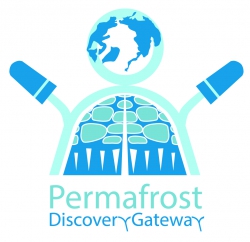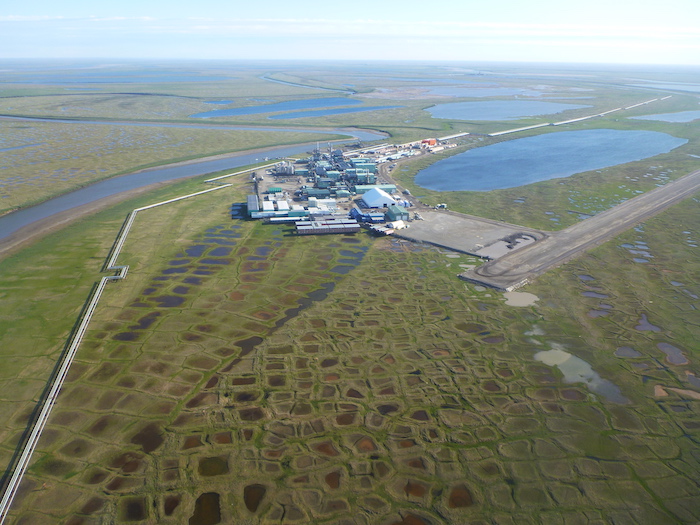
By: Anna K. Liljedahl and Benjamin M. Jones, Water and Environmental Research Center at the University of Alaska Fairbanks; Kenton McHenry and Aiman Soliman, National Center for Supercomputing Applications at the University of Illinois Urbana-Champaign; Matthew B. Jones and Amber Budden, Arctic Data Center at the National Center for Ecological Analysis and Synthesis; Jason Cervenec and Aaron Wilson, Byrd Polar and Climate Research Center at the Ohio State University; Chandi Witharana, Department of Natural Resources and Environment at the University of Connecticut; Guido Grosse and Ingmar Nitze, Alfred Wegener Institute Helmholtz Centre for Polar and Marine Research; Michael Brubaker, Center for Climate and Health at the Alaska Pacific University; Galina Wind, Science Systems and Applications Inc. at the NASA Goddard Space Flight Center; and Jennifer Moss, eCampus at the University of Alaska Fairbanks.
In this multi-institutional NSF-Navigating the New Arctic (NNA) project, we seek to empower the broader Arctic community with an online platform, the Permafrost Discovery Gateway (PDG), aimed at making big imagery permafrost information accessible and discoverable to enable knowledge-generation by researchers and the public. Permafrost science, local engineering problems, as well as community planning and global carbon studies, have all faced challenges that hindered integration and knowledge advancements due to scale-decoupled coarse (>25 km2) pan-Arctic modeling projections and sparse point (<1 m2) field measurements (Vorosmarty et al. 2018). The Permafrost Discovery Gateway will bridge this gap by creating pan-Arctic data products that encompass relevant spatial (down to sub-meter) and temporal scales (down to daily) and by providing easy access and discovery of these large datasets through visualization tools accessible through an interactive web browser.

The project is a four-year long collaboration involving eight organizations in its core team. The home of the PDG will be the Arctic Data Center at the National Center for Ecological Analysis and Synthesis (NCEAS) that is the data repository for all Arctic NSF-funded projects. The University of Alaska Fairbanksis the overall project lead. The National Center for Supercomputing Applications (NCSA) at the University of Illinois at Urbana-Champaign will play a critical role in transforming the experimental work done at local scales using artificial intelligence to detect permafrost features into efficient workflows for pan-Arctic scales as well as provide the project with a component called Clowder, which supports data management, curation, and analysis and that recently won an NSF Cyberinfrastructure for Sustained Scientific Innovation award. Byrd Polar and Climate Research Center at Ohio State University will refine their visualization tool, Fluid Earth Viewer, for the PDG user community. The University of Connecticut and the Alfred Wegener Institute are developing pan-Arctic remote sensing permafrost products and NASA will be contributing atmospheric geospatial datasets. The Center for Climate and Health at the Alaska Pacific University is, through the Local Environmental Observers Network, serving as the link to Arctic community members and subsistence practitioners. A multitude of external collaborators including individuals and organizations such as the Polar Geospatial Center, enable content and design. The combination of existing resources will help the world keep informed about the rapidly changing Arctic landscape as it is transforming and at a scale that is relevant to people and stakeholders.
The end-users serve as a major source of guidance in a successful development of the PDG. Engagement of researchers, stakeholders, and industry from the outset are key to build adoption and ensure a well-designed, intuitive, user-focused gateway. Feedback topics may include current geospatial products to include: pan-Arctic applications of existing regional remote sensing models; how to most effectively visualize the information; and how to design the overall PDG user experience including the interaction with the machine and deep learning model tools/extractors. Starting in spring 2020, the core team will be holding online and in-person meetings to create an opportunity for user-specific dialogue and to ensure that each group's needs are adequately expressed, heard, and understood. At a minimum, in-person meetings will occur through short workshops during conferences, which in year 2020 will include the Alaska Tribal Conference on Environmental Management in Anchorage and the 16th International Circumpolar Remote Sensing Symposium in Fairbanks. Remote participation community meetings will be held at least twice a year through the Zoom software. Project updates will be shared via the PDG website, Facebook group, and email list serve. In addition, the PDG webpage contains a link to leave written feedback to the core team.
Further information is available on the Permafrost Discovery Gateway project webpage and see the related NSF awards here and here.
References
Vorosmarty, C., M. Rawlins, L.Hinzman, J. Francis, M. Serreze, A. Liljedahl, K. McDonald, M. Piasecki and R. Rich. 2018. Opportunities and challenges in Arctic System Synthesis: A consensus report from the Arctic research community. New York, NY: City University of New York.
About the Authors
 Anna Liljedahl is a Research Associate Professor at the Water and Environmental Research Center at the University of Alaska Fairbanks. Growing up in northern Sweden, Anna Liljedahl enjoyed playing with the abundant meltwater flowing behind the small family farm in spring. At the University Alaska Fairbanks she researched the controls and fate of water under a changing Arctic climate through collaborations in field measurements, numerical modeling, remote sensing and, in the coming years, big data cyberinfrastructure.
Anna Liljedahl is a Research Associate Professor at the Water and Environmental Research Center at the University of Alaska Fairbanks. Growing up in northern Sweden, Anna Liljedahl enjoyed playing with the abundant meltwater flowing behind the small family farm in spring. At the University Alaska Fairbanks she researched the controls and fate of water under a changing Arctic climate through collaborations in field measurements, numerical modeling, remote sensing and, in the coming years, big data cyberinfrastructure.
 Benjamin M. Jones is a Research Professor in the Institute of Northern Engineering, Water and Environmental Research Center at the University of Alaska Fairbanks. He is leading the Permafrost Coastal Systems Network project and collaborates on numerous other NSF-funded projects focused on changing permafrost landscapes in the Arctic.
Benjamin M. Jones is a Research Professor in the Institute of Northern Engineering, Water and Environmental Research Center at the University of Alaska Fairbanks. He is leading the Permafrost Coastal Systems Network project and collaborates on numerous other NSF-funded projects focused on changing permafrost landscapes in the Arctic.
 Kenton McHenry is Director of Software at the National Center for Supercomputing Applications (NCSA) at the University of Illinois at Urbana-Champaign. NCSA is pioneering approaches to better support current software development activities within research endeavors and is developing a number of components towards an envisioned research cybinfrastructure ecosystem such as Brown Dog, Clowder, Whole Tale, 4CeeD.
Kenton McHenry is Director of Software at the National Center for Supercomputing Applications (NCSA) at the University of Illinois at Urbana-Champaign. NCSA is pioneering approaches to better support current software development activities within research endeavors and is developing a number of components towards an envisioned research cybinfrastructure ecosystem such as Brown Dog, Clowder, Whole Tale, 4CeeD. Matt Jones is Principal Investigator at the Arctic Data Center at the National Center for Ecological Analysis and Synthesis. His research focuses on environmental informatics, and particularly software for management, integration, analysis, and modeling of heterogeneous environmental data. Recent projects have produced effective new techniques for information management and analysis, including metadata standards, data management software, and data analysis software such as scientific workflow systems.
Matt Jones is Principal Investigator at the Arctic Data Center at the National Center for Ecological Analysis and Synthesis. His research focuses on environmental informatics, and particularly software for management, integration, analysis, and modeling of heterogeneous environmental data. Recent projects have produced effective new techniques for information management and analysis, including metadata standards, data management software, and data analysis software such as scientific workflow systems.
 Amber Budden, Co-Investigator, DataOne, at the Arctic Data Center at the National Center for Ecological Analysis and Synthesis. Her research interests are publication practices, bibliometrics, gender representation, education, and more recently open data. She also oversees community engagement and outreach for the Arctic Data Center in addition to participating in related training events.
Amber Budden, Co-Investigator, DataOne, at the Arctic Data Center at the National Center for Ecological Analysis and Synthesis. Her research interests are publication practices, bibliometrics, gender representation, education, and more recently open data. She also oversees community engagement and outreach for the Arctic Data Center in addition to participating in related training events.
 Chandi Witharana is an Assistant Research Professor in the Department of Natural Resources and the Environment at the University of Connecticut. His research interests capture the methodological developments and adaptations to unseal faster, deeper, and more accurate analysis of large volumes of high-resolution remote sensing data.
Chandi Witharana is an Assistant Research Professor in the Department of Natural Resources and the Environment at the University of Connecticut. His research interests capture the methodological developments and adaptations to unseal faster, deeper, and more accurate analysis of large volumes of high-resolution remote sensing data.
 Mike Brubaker is Director of the Center for Climate and Health at Alaska Pacific University (APU). He is part of the team involved with collection and analysis of permafrost-event related news articles and first-person observations published to the LEO Network. The purpose is to provide a mechanism for observational contributions to Permafrost Discovery Gateway, and a view of the impacts that Arctic communities are experiencing related to permafrost and climate change.
Mike Brubaker is Director of the Center for Climate and Health at Alaska Pacific University (APU). He is part of the team involved with collection and analysis of permafrost-event related news articles and first-person observations published to the LEO Network. The purpose is to provide a mechanism for observational contributions to Permafrost Discovery Gateway, and a view of the impacts that Arctic communities are experiencing related to permafrost and climate change. Jennifer Moss, University of Alaska, Fairbanks, is interested in emergent ideas such as digital storytelling, augmented reality, interactive media, and wearable devices and how they can help facilitate successful educational experiences.
Jennifer Moss, University of Alaska, Fairbanks, is interested in emergent ideas such as digital storytelling, augmented reality, interactive media, and wearable devices and how they can help facilitate successful educational experiences.
 Aiman Soliman, University of Illinois. His research work is focused on studying land use/land cover change through the lens of spatial big data for a variety of outcomes, specifically human health and urban sustainability.
Aiman Soliman, University of Illinois. His research work is focused on studying land use/land cover change through the lens of spatial big data for a variety of outcomes, specifically human health and urban sustainability.
 Gala Wind, NASA. Her research interests are remote sensing of clouds and aerosols, software development, crossing modeling with remote sensing, and radiative transfer.
Gala Wind, NASA. Her research interests are remote sensing of clouds and aerosols, software development, crossing modeling with remote sensing, and radiative transfer. Jason Cervenec, Ohio State University, is the Education and Outreach Director for the Byrd Polar and Climate Research Center at The Ohio State University. The diverse outreach portfolio of the Center reaches approximately 12,000 individuals annually and includes programs in cutting edge science, science education, history, and the arts.
Jason Cervenec, Ohio State University, is the Education and Outreach Director for the Byrd Polar and Climate Research Center at The Ohio State University. The diverse outreach portfolio of the Center reaches approximately 12,000 individuals annually and includes programs in cutting edge science, science education, history, and the arts.
 Aaron Wilson, Ohio State University, is an Atmospheric Scientist at The Ohio State University (OSU), holding a joint appointment as a Senior Research Associate at the Byrd Polar & Climate Research Center (BPCRC) and climate specialist with OSU Extension-the outreach arm of the College of Food, Agricultural, and Environmental Sciences.
Aaron Wilson, Ohio State University, is an Atmospheric Scientist at The Ohio State University (OSU), holding a joint appointment as a Senior Research Associate at the Byrd Polar & Climate Research Center (BPCRC) and climate specialist with OSU Extension-the outreach arm of the College of Food, Agricultural, and Environmental Sciences.
 Guido Grosse, Alfred Wegener Institute Helmholtz Centre for Polar and Marine Research, his research interests are permafrost in the Earth system, Arctic landscape dynamics, remote sensing of permafrost regions, permafrost thaw, permafrost hydrology, permafrost carbon dynamics.
Guido Grosse, Alfred Wegener Institute Helmholtz Centre for Polar and Marine Research, his research interests are permafrost in the Earth system, Arctic landscape dynamics, remote sensing of permafrost regions, permafrost thaw, permafrost hydrology, permafrost carbon dynamics.
 Ingmar Nitze, Alfred Wegener Institute Helmholtz Centre for Polar and Marine Research, his research interests are detecting rapid landscape dynamics in permafrost regions using the extensive Landsat archive.
Ingmar Nitze, Alfred Wegener Institute Helmholtz Centre for Polar and Marine Research, his research interests are detecting rapid landscape dynamics in permafrost regions using the extensive Landsat archive.
